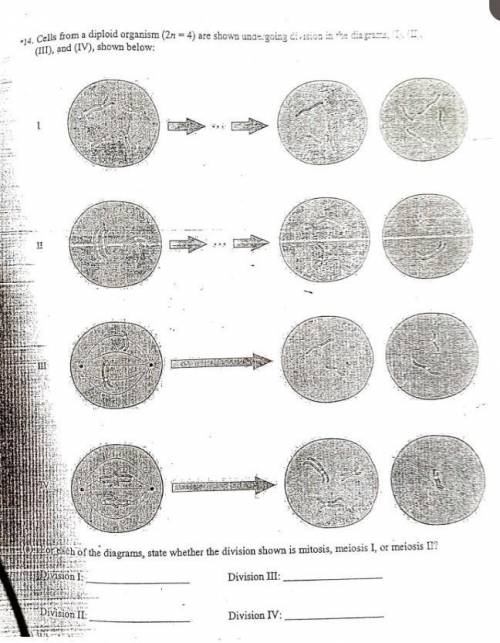
Biology, 10.03.2021 18:30 macymichtavy
Cells from a diploid organism (2n=4) are shown undergoing division in the diagrams, (I), (II), (III), and (IV), shown above.
a) For each of the diagrams, state whether the division shown is mitosis, meiosis I, or meiosis II?
i) Division I
ii) Division II
iii) Division III
iv) Division IV
b) Which diagramS show synapsed chromosomes?
c) Which of the above diagrams starts with a haploid cell?
d) In which diagram did segregation of both chromosome pairs occur?
e) What is the term that best describes the phenomenon that occured in the division of diagram IV?
I need help with this URGENTLY, PLEASE! It's not compulsory for one person to answer all the questions. But if you know the answers to all, kindly share please, please. Explanation will be highly appreciated. THANK YOU!!!


Answers: 3
Another question on Biology

Biology, 22.06.2019 02:00
The accompanying figure shows the percent of selected dna sequences that match between a chimpanzee and other primates. these data support the hypothesis that the figure shows the percentage of selected d n a sequences that match between the chimpanzee and other primates. the human has an almost 98 percent match, the gorilla has an almost 97 percent match, the orangutan has a 96 percent match, the gibbon has an almost 95 percent match, and the old world monkey has an almost 92 percent match. the accompanying figure shows the percent of selected dna sequences that match between a chimpanzee and other primates. these data support the hypothesis that the figure shows the percentage of selected d n a sequences that match between the chimpanzee and other primates. the human has an almost 98 percent match, the gorilla has an almost 97 percent match, the orangutan has a 96 percent match, the gibbon has an almost 95 percent match, and the old world monkey has an almost 92 percent match. chimpanzees and gibbons are the most closely related the chimpanzee's closest surviving relative is humans orangutans are the primates least closely related to chimpanzees old world monkeys and gibbons are the most closely related
Answers: 1

Biology, 22.06.2019 07:00
What molecules will be best used to compare different species with the exact same sequence of amino acids? why would two species have the same protein even if the molecules in question is different? (hint: transcription to translation to protein).
Answers: 1

Biology, 22.06.2019 09:30
Juan and carol were studying invertebrates in biology. they knew that segmented or earth worms preferred a dark, moist habitat. during this lab, they would be investigating the responses of organisms called planaria or dugesia tigrina. these were simple flatworms that still had a one-way digestive system and a very simple nervous system. juan and carol placed the planaria in a petri dish containing cool, distilled water that was partially covered with black paper. they shined a light on the dish. next, they removed the paper and placed a small amount of chicken liver at one end of the dish. they added a few large salt crystals to the water. finally, they added drops of hot water to the cool water in the petri dish. their results can be seen in the data table. according to their experiment, all but one conclusion is valid.
Answers: 1

Biology, 22.06.2019 12:00
Can a trait be both polygenic and have multiple alleles? explain why or why not.
Answers: 2
You know the right answer?
Cells from a diploid organism (2n=4) are shown undergoing division in the diagrams, (I), (II), (III)...
Questions


Mathematics, 16.10.2019 20:30


Mathematics, 16.10.2019 20:30

History, 16.10.2019 20:30




Spanish, 16.10.2019 20:30

Geography, 16.10.2019 20:30


Mathematics, 16.10.2019 20:30





Social Studies, 16.10.2019 20:30

History, 16.10.2019 20:30




